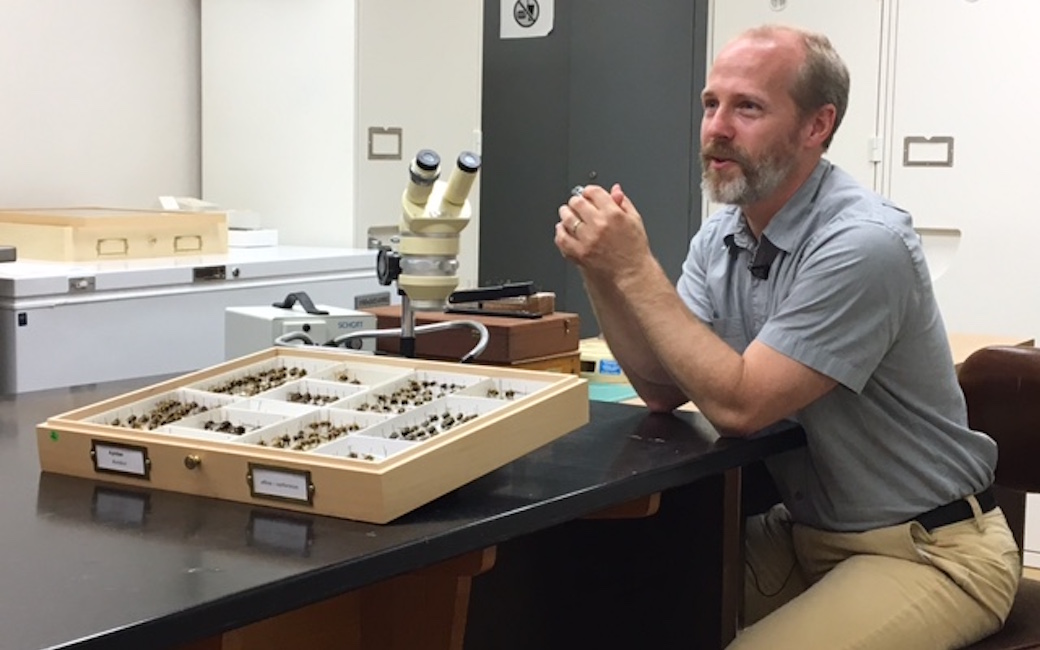TU's Bombus affinis collection is the bees' knees
TU's collection is an important part of understanding bees and how they’re doing in a changing environment.
By Sedonia Martin on July 31, 2017

Bees are ignored, underappreciated and feared by people, but they make the world run. Their mysterious worldwide decline has caused consternation and concern among entomologists and conservationists alike.
During a recent interview, Towson University associate professor John S. LaPolla, Ph.D., (biological sciences, Fisher College of Science & Mathematics) explained to Catherine Hawley of WMAR-TV, the scientific value of the TU insect collections in understanding the common bumble bee decline in our region.
“Bees are really important for how the environment is functioning,” said LaPolla. “We have these biological collections, and they are important resources on understanding how they’re doing out there as in terms of how humans have changed the environment.
“It’s important to keep in mind that insect species get impacted in very serious ways by humans. We don’t think about insect conservation, and it’s important to pay attention to them.”
Watch the interview that aired on Wednesday, July 26
Below is a condensed version of LaPolla and Hawley's conversation.
What are common bees in this region?
The Bombus affinis or the rusty patched bumble bee was very common to this region in the ‘80s and are now gone. Several bumble bee species have experienced rapid declines. These are native to the region, and about 87 percent of its range has contracted. They are found now in the upper mid-West. Thirty years ago this was a quite abundant species, and now we are not finding any. Not all bumble bee species have vanished from Maryland; however, the species have declined.
How many bees do we have in the TU collection and how far do they date back?
We have about 6,000–7,000 local bees in the TU collection. We have a large collection of bumble bees that dates back to the 1930s. There was a lot of intense collection during the early to mid-1980s, in particular, from around the Phoenix area of Baltimore County. About 1,000 bees were collected. All the species known to the Maryland area were collected during the 1980s period. This gives scientists and idea of what the abundance might have been, and we can do similar sampling over time to determine the decline. The TU collection provides this perspective. Our research seems to suggest that overall their abundance has changed. This is a potential cause for concern.
Why should we care?
The bumble bee can serve as the “canary-in-the-coal-mines” if you will. If a species is declining, we need to ask “why?” Is it environmental, chemical changes, implications of climate change, pesticides, diseases, habitat loss, as farms disappear? How have these and other factors impacted overall diversity? Probably a combination of all these factors that have caused overall declines. Bumble bees are important for crops—they do “buzz”pollination. They buzz when they land on plants, such as tomatoes, beans; bumble bees are very important. Wild bumble bees are ideal for this economic benefit. We want to pay attention because we don’t understand why it’s happening, and we need to know.
How does this affect the environment?
As groups of species decline, it will impact the plant population. It can affect other plants and animals that depend on the species. Some wildflowers are almost totally dependent on these species. There may be other bee species whose populations have increased that have replaced the declining species. It stands to reason that these types of changes are impacting these other species.
How large and old is the collection?
It’s around 100,000 specimens and mainly dates from the 1930s to present, though we do have some specimens that go back further. It’s a combination of efforts that have built the collection and includes student projects and collections, graduate student projects and local entomologists have donated their collections. It’s largely Maryland- and mid-Atlantic-based; however, we do have specimens from around the world.
What type of different insects?
We have a wide range of groups of insects from flies to grasshoppers to bees. The collection is especially in strong in some species. We have a butterfly collection that spans several decades, and a strong bee collection. These collections have large groups of specimens and range in time in terms of how far back they goes.
Why is a collection like this valuable?
First and foremost, it gives us an historical record of what occurred where and when. When we consider the diversity of most species, we don’t have a clear idea of where they occurred and when they occurred. So collections like this give us an historical perspective of how changes may be happening. It’s a long-term perspective. Collections like we have at TU are really important for documenting that kind of information.